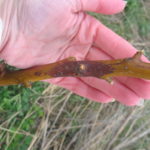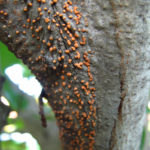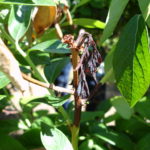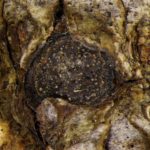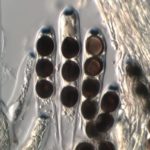Diseases that affect the twigs, branches, and the main trunk of a tree are referred to as cankers or blights. Canker diseases can be a serious problem in the orchard, vineyard, berry or bramble patch when they are not properly managed, and even when they are. All woody plants can be infected by canker pathogens.
Cankers appear as a general sunken area of darkened tissue on the twigs or branches, often surrounding a branch stub(Fig. 1). Many canker pathogens produce perithecia, which contain sacs of spores (asci) that forcibly release the spores when the conditions are right. The perithecia are easy to find on the surface of the canker (Figure 2). As the canker grows, the twig or branch may become girdled, causing the wilting and death of the leaves past the point of infection on the tree. On stone fruit, this can cause gummosis, too (Fig. 3).
What causes cankers? Many different fungi (and a few bacteria!) cause cankers. Some of the major players are: Nectria twig blight (pathogen: Nectria cinnabarina), Nectria canker (Nectria galligena), anthracnose canker (Pezicula malicorticis), Phomopsis canker (Diaporthe perniciosa), nailhead canker (Biscogniauxia marginata), and Monochaetia twig canker (Seiridium unicorne). Cytospora canker, caused by many different species asexual forms of Valsa or Leucostoma, are also common opportunistic pathogens. All of these can be a problem for Indiana growers.
- Figure 1. The branch stub serves as a wound that enables a pathogen, in this case, Nectria spp., to infect. Photo by Janna Beckerman.
- Figure 2. The erumpent pimples on the surface are where the perithecia are breaking through. Photo by Janna Beckerman.
- Figure 3. Opportunistic canker pathogens on peach, plum and cherry are often associated with gummosis. Photo by Janna Beckerman.
Symptoms and Signs
Nectria twig blight is often mistaken for fire blight because of the wilting that occurs due to the girdling of the twig by small cankers . However, unlike fire blight, there is no blighting of the blossoms, and the shoots do not die from the tip. Bright pink cushions of fungi called sporodochia can be found in the dead tissue of the canker (Fig. 4). This disease is more common on trees of moderate vigor.
Nectria canker is first found at the node , and appears as a darkened elliptical, sunken area. Bright red to orange perithecia are often observed on the canker in the winter. It is most common on Gravenstein, Delicious, McIntosh, Newtown, Spitzenburg, Cox’s Orange Pippen, and Honeycrisp, but other cultivars are also susceptible.
Anthracnose canker first appears as small, circular red or purple spots when moist. As the canker enlarges, the spots become elliptical, sunken orange to brown areas. Cracks will eventually develop between the healthy and infected tissue, and cream-colored acervuli will appear. The cultivars Ruby Mac, Linda Mac, Spartan, Gravenstein, and Baldwin are most susceptible to anthracnose canker.
Phomopsis canker (Fig. 5) and Monochaetia twig canker are generally secondary and only infect dead or dying tissue. This often happens after herbicide injury or winter injury.
Nailhead canker, also called blister canker, tends to flare up after drought years. This opportunistic pathogen attacks stressed trees. This was a serious problem leading up to the 1900s in the Midwest and resulted in many growers no longer planting Ben Davis or Baldwin, which were considered most susceptible. The ‘nailheads’ are composed of perithecia (Fig. 6), each filled with sac of ascospores (Fig 7).
- Figure 4. The coral fungus, Nectria spp., gets it name from the pink fruiting bodies that break through the bark. Photo by Janna Beckerman.
- Figure 5. Phomopsis canker on blueberry causes flagging and dieback. Photo by Bruce Bordelon.
- Figure 6. Perithecia of nailhead canker. Photo by Paul Cannon.
- Figure 7. Asci and ascospores of the naihead pathogen. Photo by Paul Cannon.
Disease Cycle
Canker diseases generally survive the winter in the canker tissue as mycelium and/or conidia. The pathogens spread by conidia and/or ascospores that are dispersed by either wind or water. Most canker-causing fungi infect through a wound such as a pruning cut, a leaf scar, herbicide drift injury, or other damaged tissue. The one exception is the anthracnose pathogen which penetrates through the bark directly. Moist weather tends to favor disease development, and disease development can occur at a wide range of temperatures. New cankers tend to form in either the fall or spring, and this is also when most canker diseases are actively producing inoculum.
Management
Although there are many different pathogens that cause canker, management strategies are quite similar for all of them. The most effective tool in managing canker diseases is the removal of cankered tissue from the orchard, vineyard or berry patch. Infected branches should be pruned and then removed from the orchard or burned. Be sure to prune back at least 15” to remove the fungus completely. By removing infected plant material from the orchard, the inoculum level is reduced, and the chances for new infection to occur are reduced. As the diseases generally enter through a wound, care should be taken in pruning, and mechanical damage from machinery should be minimized. You can’t treat trees with a fungicide after infection. The best you can do is prevent infection from occurring by irrigating during drought periods, careful use of all herbicides, proper fertilization (not after July 1 to allow trees to harden off before winter), and proper pruning to minimize branch stubs. Most fungicides used to control other diseases (captan, and the 7-11 fungicides like Pristine, Merivon, and Luna Sensation) are effective in preventing these diseases, particularly after a wind or hail event. However, fungicide use should be reserved for blocks with a history of problems with the diseases, and even then, underlying problems need to be corrected.
